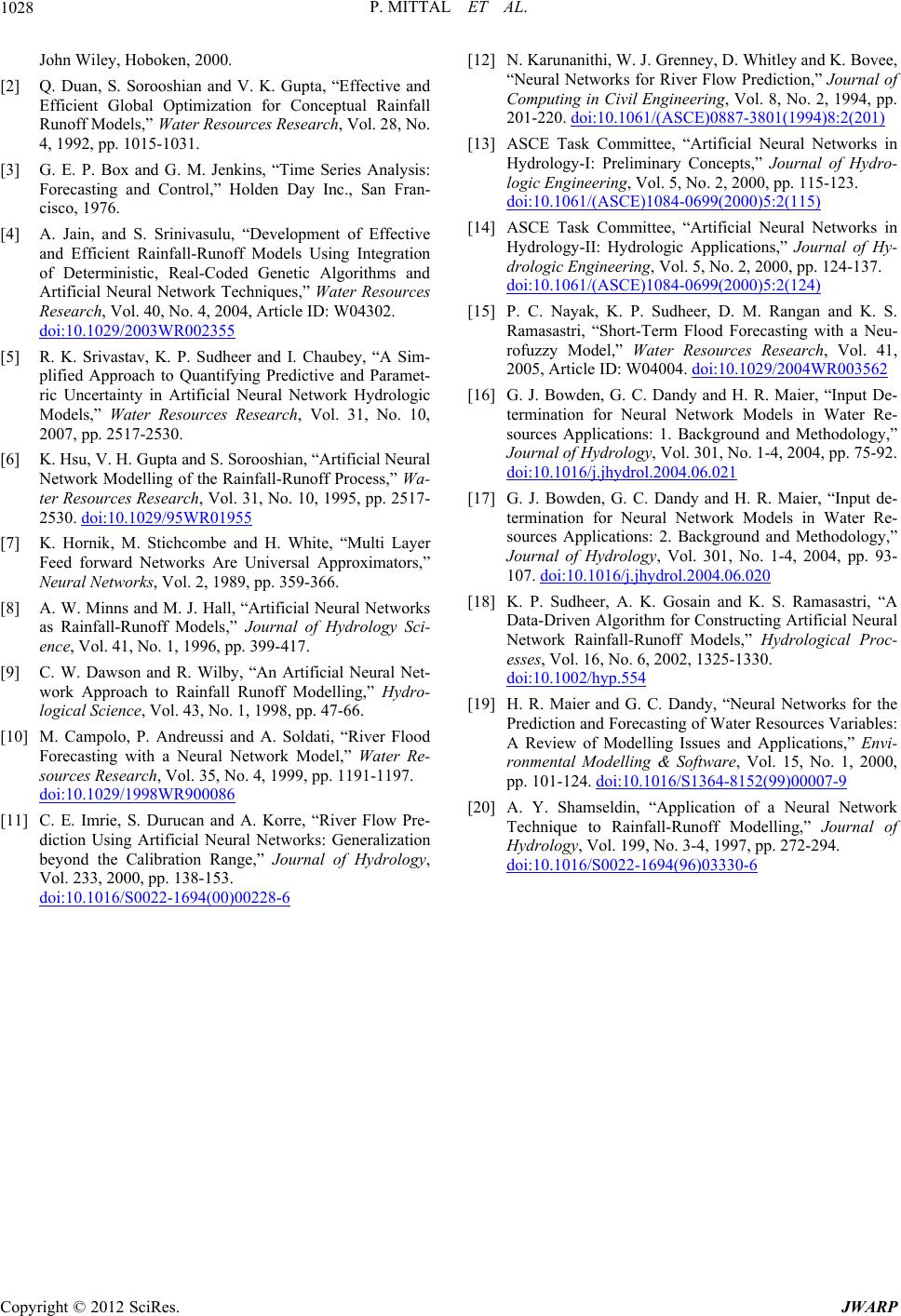
P. MITTAL ET AL.
1028
John Wiley, Hoboken, 2000.
[2] Q. Duan, S. Sorooshian and V. K. Gupta, “Effective and
Efficient Global Optimization for Conceptual Rainfall
Runoff Models,” Water Resources Research, Vol. 28, No.
4, 1992, pp. 1015-1031.
[3] G. E. P. Box and G. M. Jenkins, “Time Series Analysis:
Forecasting and Control,” Holden Day Inc., San Fran-
cisco, 1976.
[4] A. Jain, and S. Srinivasulu, “Development of Effective
and Efficient Rainfall-Runoff Models Using Integration
of Deterministic, Real-Coded Genetic Algorithms and
Artificial Neural Network Techniques,” Water Resources
Research, Vol. 40, No. 4, 2004, Article ID: W04302.
doi:10.1029/2003WR002355
[5] R. K. Srivastav, K. P. Sudheer and I. Chaubey, “A Sim-
plified Approach to Quantifying Predictive and Paramet-
ric Uncertainty in Artificial Neural Network Hydrologic
Models,” Water Resources Research, Vol. 31, No. 10,
2007, pp. 2517-2530.
[6] K. Hsu, V. H. Gupta and S. Sorooshian, “Artificial Neural
Network Modelling of the Rainfall-Runoff Process,” Wa-
ter Resources Research, Vol. 31, No. 10, 1995, pp. 2517-
2530. doi:10.1029/95WR01955
[7] K. Hornik, M. Stichcombe and H. White, “Multi Layer
Feed forward Networks Are Universal Approximators,”
Neural Networks, Vol. 2, 1989, pp. 359-366.
[8] A. W. Minns and M. J. Hall, “Artificial Neural Networks
as Rainfall-Runoff Models,” Journal of Hydrology Sci-
ence, Vol. 41, No. 1, 1996, pp. 399-417.
[9] C. W. Dawson and R. Wilby, “An Artificial Neural Net-
work Approach to Rainfall Runoff Modelling,” Hydro-
logical Science, Vol. 43, No. 1, 1998, pp. 47-66.
[10] M. Campolo, P. Andreussi and A. Soldati, “River Flood
Forecasting with a Neural Network Model,” Water Re-
sources Research, Vol. 35, No. 4, 1999, pp. 1191-1197.
doi:10.1029/1998WR900086
[11] C. E. Imrie, S. Durucan and A. Korre, “River Flow Pre-
diction Using Artificial Neural Networks: Generalization
beyond the Calibration Range,” Journal of Hydrology,
Vol. 233, 2000, pp. 138-153.
doi:10.1016/S0022-1694(00)00228-6
[12] N. Karunanithi, W. J. Grenney, D. Whitley and K. Bovee,
“Neural Networks for River Flow Prediction,” Journal of
Computing in Civil Engineering, Vol. 8, No. 2, 1994, pp.
201-220. doi:10.1061/(ASCE)0887-3801(1994)8:2(201)
[13] ASCE Task Committee, “Artificial Neural Networks in
Hydrology-I: Preliminary Concepts,” Journal of Hydro-
logic Engineering, Vol. 5, No. 2, 2000, pp. 115-123.
doi:10.1061/(ASCE)1084-0699(2000)5:2(115)
[14] ASCE Task Committee, “Artificial Neural Networks in
Hydrology-II: Hydrologic Applications,” Journal of Hy-
drologic Engineering, Vol. 5, No. 2, 2000, pp. 124-137.
doi:10.1061/(ASCE)1084-0699(2000)5:2(124)
[15] P. C. Nayak, K. P. Sudheer, D. M. Rangan and K. S.
Ramasastri, “Short-Term Flood Forecasting with a Neu-
rofuzzy Model,” Water Resources Research, Vol. 41,
2005, Article ID: W04004. doi:10.1029/2004WR003562
[16] G. J. Bowden, G. C. Dandy and H. R. Maier, “Input De-
termination for Neural Network Models in Water Re-
sources Applications: 1. Background and Methodology,”
Journal of Hydrology, Vol. 301, No. 1-4, 2004, pp. 75-92.
doi:10.1016/j.jhydrol.2004.06.021
[17] G. J. Bowden, G. C. Dandy and H. R. Maier, “Input de-
termination for Neural Network Models in Water Re-
sources Applications: 2. Background and Methodology,”
Journal of Hydrology, Vol. 301, No. 1-4, 2004, pp. 93-
107. doi:10.1016/j.jhydrol.2004.06.020
[18] K. P. Sudheer, A. K. Gosain and K. S. Ramasastri, “A
Data-Driven Algorithm for Constructing Artificial Neural
Network Rainfall-Runoff Models,” Hydrological Proc-
esses, Vol. 16, No. 6, 2002, 1325-1330.
doi:10.1002/hyp.554
[19] H. R. Maier and G. C. Dandy, “Neural Networks for the
Prediction and Forecasting of Water Resources Variables:
A Review of Modelling Issues and Applications,” Envi-
ronmental Modelling & Software, Vol. 15, No. 1, 2000,
pp. 101-124. doi:10.1016/S1364-8152(99)00007-9
[20] A. Y. Shamseldin, “Application of a Neural Network
Technique to Rainfall-Runoff Modelling,” Journal of
Hydrology, Vol. 199, No. 3-4, 1997, pp. 272-294.
doi:10.1016/S0022-1694(96)03330-6
Copyright © 2012 SciRes. JWARP